 Other than noodles, the greatest contribution the Chinese have made to Thai cooking, at least in my opinion, is khao tom. The Thai words literally mean "boiled rice," but in this case they refer to restaurants that serve a variety Chinese/Thai dishes to order, often with small bowls of watery rice. One of my favourite khao tom places in Bangkok is Khao Tom Jay Suay, an ancient shophouse restaurant in Chinatown. The restaurant is colloquially known as Khao Tom Roy Pee, "100 Year Old Khao Tom," but I was told it's really only about 50 years old.
Other than noodles, the greatest contribution the Chinese have made to Thai cooking, at least in my opinion, is khao tom. The Thai words literally mean "boiled rice," but in this case they refer to restaurants that serve a variety Chinese/Thai dishes to order, often with small bowls of watery rice. One of my favourite khao tom places in Bangkok is Khao Tom Jay Suay, an ancient shophouse restaurant in Chinatown. The restaurant is colloquially known as Khao Tom Roy Pee, "100 Year Old Khao Tom," but I was told it's really only about 50 years old.
You can recognise Khao Tom Jay Suay by the vast table out front holding the restaurant's huge array of raw ingredients, mostly different types of vegetables:

Directly behind this, and shown at the top of this post, a fellow works a station with several prepared dishes. These include several types of meats and fish, a few stir-fried dishes and soups such as jap chai, a type of vegetable-heavy Chinese stew. He shouts the orders out to two additional stations within the restaurant, a soup station and a separate stir-fry station, and as far as I could tell, no order is recorded on paper.
Must-order dishes at Jay Suay include the delicious smoked duck; muu phat nam liap, minced pork fried with salted Chinese olive; the previously-mentioned jap chai; and any flash-fried veggie dish. On our visit we ordered all of these, as well as a stink bean stir-fry, a tom yam of squid and mushrooms, and a salad of plaa salit thot, a type of deep-fried fish:

You'll be sitting on the side of a smelly street and it will inevitably be hot, but the food is full-flavoured and excellent.
Khao Tom Jay Suay 547 Thanon Phlap Phla Chai 02 223 9592
View Thai Eats in a larger map












 Cambodia isn't generally known as a culinary destination, but I really enjoyed the eats during five recent days in Siem Reap. The quality of the city's foreign cuisine, particularly its French, was much better than that of a huge city like Bangkok. Among other meals, we had a fun lunch at
Cambodia isn't generally known as a culinary destination, but I really enjoyed the eats during five recent days in Siem Reap. The quality of the city's foreign cuisine, particularly its French, was much better than that of a huge city like Bangkok. Among other meals, we had a fun lunch at 

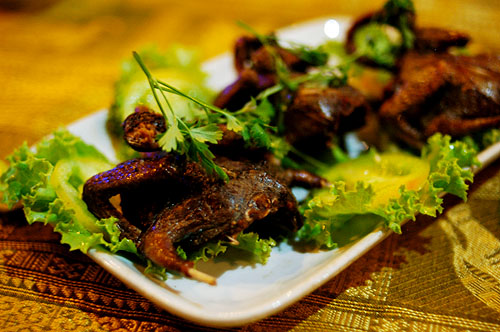

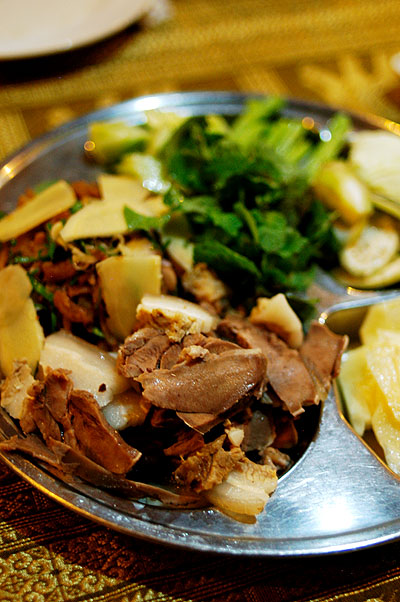


 As mentioned previously, Mae Hong Son was pretty wet, so we spent a lot of our time indoors, much of it eating and drinking. Of all the things we consumed there, I'm pretty sure that the local sweets were the biggest hit among the two chefs. We bought several banana leaf packages of the sweets on a daily basis, and they never seemed to tire of them.
As mentioned previously, Mae Hong Son was pretty wet, so we spent a lot of our time indoors, much of it eating and drinking. Of all the things we consumed there, I'm pretty sure that the local sweets were the biggest hit among the two chefs. We bought several banana leaf packages of the sweets on a daily basis, and they never seemed to tire of them.

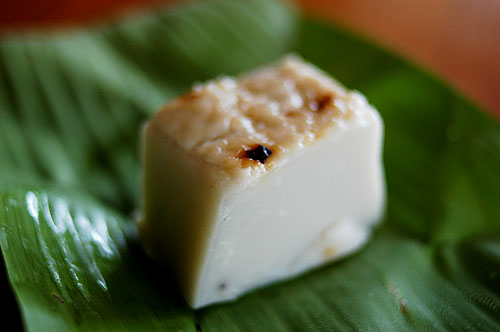
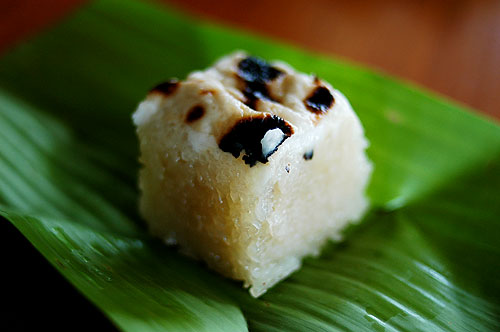

 Heaps of exposure this month: in addition to pieces in about four different in-flight mags, if you rush to your local bookist you can find two pieces I did in this this month's Travel + Leisure Southeast Asia, including a roundup of the best places to get your khao soi on in Chiang Mai. I contributed a short piece on Bangkok eats to this month's Saveur (there's also
Heaps of exposure this month: in addition to pieces in about four different in-flight mags, if you rush to your local bookist you can find two pieces I did in this this month's Travel + Leisure Southeast Asia, including a roundup of the best places to get your khao soi on in Chiang Mai. I contributed a short piece on Bangkok eats to this month's Saveur (there's also  How many different dishes can one make with some form of carbohydrate, shrimp and the occasional pork rind? Leave it to the Vietnamese to have created a fantastic number of dishes using these relatively limited ingredients, all of them creative and delicious.
How many different dishes can one make with some form of carbohydrate, shrimp and the occasional pork rind? Leave it to the Vietnamese to have created a fantastic number of dishes using these relatively limited ingredients, all of them creative and delicious.


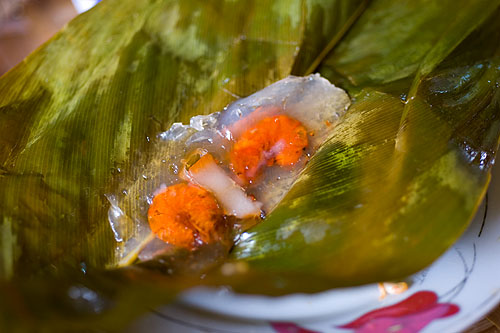
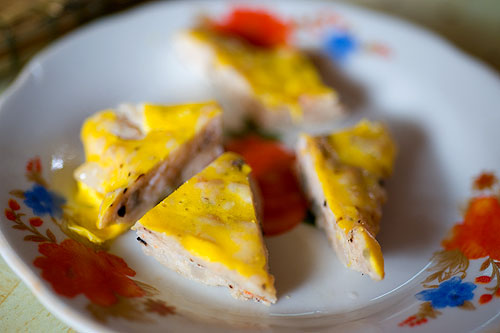
 Often it's little more than an atmospheric locale that draws me a to a particular vendor or restaurant:
Often it's little more than an atmospheric locale that draws me a to a particular vendor or restaurant:



 I must admit that of the reasons I was most excited to visit Vietnam was because I knew I'd be able to consume bánh mì, Vietnamese-style baguette sandwiches, on a daily basis. This dish is virtually non-existent in Bangkok, and is in my opinion, the perfect sandwich. Unfortunately, other than coincidentally stumbling across the same delicious bánh mì in Saigon that was
I must admit that of the reasons I was most excited to visit Vietnam was because I knew I'd be able to consume bánh mì, Vietnamese-style baguette sandwiches, on a daily basis. This dish is virtually non-existent in Bangkok, and is in my opinion, the perfect sandwich. Unfortunately, other than coincidentally stumbling across the same delicious bánh mì in Saigon that was 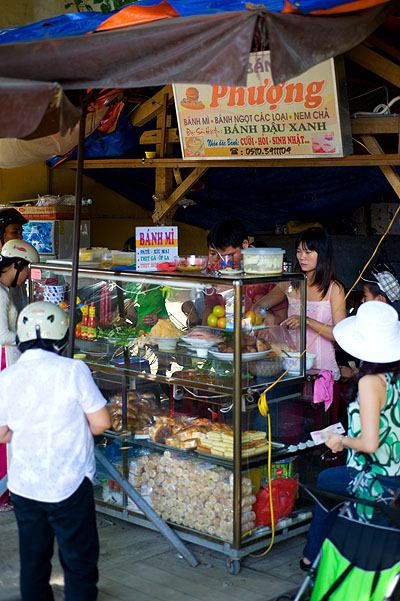

 I didn't really take to Hoi An. Don't get me wrong, the city's famed Chinese and French-colonial-style buildings were beautiful, and the setting was pleasant. But virtually every single structure seemed dedicated to selling t-shirts or overpriced food to tourists, and there seemed to be more of the latter than locals. And on top of all this, when I was in town, the town's central market was in the process of being rebuilt, which apparently caused many of the local vendors I had read about at
I didn't really take to Hoi An. Don't get me wrong, the city's famed Chinese and French-colonial-style buildings were beautiful, and the setting was pleasant. But virtually every single structure seemed dedicated to selling t-shirts or overpriced food to tourists, and there seemed to be more of the latter than locals. And on top of all this, when I was in town, the town's central market was in the process of being rebuilt, which apparently caused many of the local vendors I had read about at 

 Lonely Planet's Vietnam reckons that Bánh Xèo 46A makes the best bánh xèo in Saigon. I'm certainly no authority on the dish, a type of Vietnamese filled crepe, but I reckon Bánh Xèo 46A do the best version of the dish I've had.
Lonely Planet's Vietnam reckons that Bánh Xèo 46A makes the best bánh xèo in Saigon. I'm certainly no authority on the dish, a type of Vietnamese filled crepe, but I reckon Bánh Xèo 46A do the best version of the dish I've had. I had nearly forgotten about the Vietnamese obsession with noodles. Virtually every dish you encounter in this country contains some sort of doughy strand. There are so many noodle options I've yet to even consume a single dish of phở, arguably Vietnam's most recognized noodle dish.
I had nearly forgotten about the Vietnamese obsession with noodles. Virtually every dish you encounter in this country contains some sort of doughy strand. There are so many noodle options I've yet to even consume a single dish of phở, arguably Vietnam's most recognized noodle dish.



 As mentioned previously, this is a bit of a whirlwind trip, which leaves me relatively little time to explore dining options on my own. Knowing I'd be in Saigon I went directly to
As mentioned previously, this is a bit of a whirlwind trip, which leaves me relatively little time to explore dining options on my own. Knowing I'd be in Saigon I went directly to 



 The Socialist Republic of Vietnam, that is.
The Socialist Republic of Vietnam, that is. After a long hiatus, I find myself yet again spending quite a bit of time in Bangkok's Chinatown. This is mostly due to some photo assignments I'm working on, but I've also been making some eating trips as I now live only a couple metro stops away. As always, I've got my own repertoire of favourite stalls and dishes, but I'm also making an effort to discover some new places.
After a long hiatus, I find myself yet again spending quite a bit of time in Bangkok's Chinatown. This is mostly due to some photo assignments I'm working on, but I've also been making some eating trips as I now live only a couple metro stops away. As always, I've got my own repertoire of favourite stalls and dishes, but I'm also making an effort to discover some new places.
 I
I  I blog about phat Thai on occasion, but mostly for you people. I realize it's huge abroad, particularly in the US, but to be honest, I'm not such a big fan of the stuff. Generally find it kinda stodgy and greasy, particularly when compared to a lot of Thai food out here.
I blog about phat Thai on occasion, but mostly for you people. I realize it's huge abroad, particularly in the US, but to be honest, I'm not such a big fan of the stuff. Generally find it kinda stodgy and greasy, particularly when compared to a lot of Thai food out here.
 and happen upon a drunk Kiwi chef grilling chicken on the side of the street, don't be alarmed; foreigners haven't started taking menial jobs, and food standards haven't yet dropped that much. Rather, Hock and I simply wanted to make frango no churrasco, Portuguese-style grilled chicken.
and happen upon a drunk Kiwi chef grilling chicken on the side of the street, don't be alarmed; foreigners haven't started taking menial jobs, and food standards haven't yet dropped that much. Rather, Hock and I simply wanted to make frango no churrasco, Portuguese-style grilled chicken.

 Vegetarians, cover your eyes: this is a particularly flesh-laden post. But in its defense I'd have to say that Ko Tek Chiang 3 is one of the best uses of meat that I've encountered in a long time.
Vegetarians, cover your eyes: this is a particularly flesh-laden post. But in its defense I'd have to say that Ko Tek Chiang 3 is one of the best uses of meat that I've encountered in a long time.